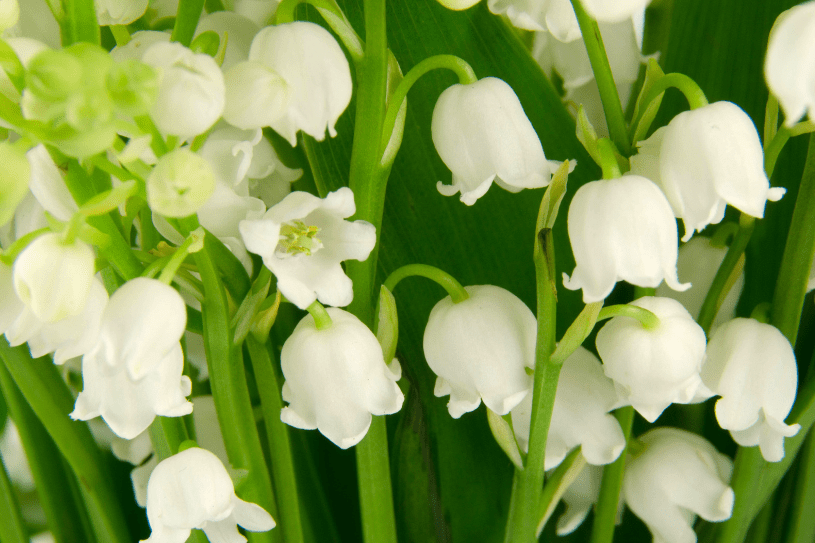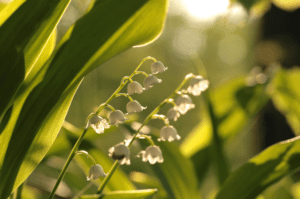
Did you know that the delicate Lily of the Valley, a symbol of purity and rebirth, is poisonous? Don’t let that deter you from cultivating this captivating perennial in your garden. With its charming bell-shaped flowers and intoxicating fragrance, Lily of the Valley adds a touch of elegance to shaded areas.
Important Note: Before diving into the beauty of Lily of the Valley, it’s crucial to remember that all parts of this plant are toxic if ingested. Keep it out of reach of children and pets, and wear gloves when handling.
Understanding Lily of the Valley
Botanical Overview
Lily of the Valley (Convallaria majalis) is a perennial plant native to Europe and Asia. It belongs to the Asparagaceae family and is known for its distinctive, fragrant flowers that bloom in late spring. The plant thrives in USDA hardiness zones 3 to 8, making it suitable for a variety of climates.
Ideal Growing Conditions
Lily of the Valley prefers shaded to partially shaded areas with rich, well-drained soil. It flourishes in cool, moist environments, making it an excellent choice for woodland gardens or shaded borders.
Planting Lily of the Valley
Site Selection
Choose a planting site with partial to full shade. The plant does well under the canopy of deciduous trees where it receives dappled sunlight. Avoid areas with heavy foot traffic as the delicate flowers and leaves can be easily damaged.
Soil Preparation
To improve drainage and fertility, prepare the soil by incorporating organic matter such as compost or well-rotted manure. Lily of the Valley prefers slightly acidic to neutral soil with a pH range of 6.0 to 7.0.
Planting Rhizomes
Lily of the Valley is typically propagated through rhizomes. Plant the rhizomes in early spring or fall, spacing them 1 to 2 inches apart and covering them with 1 inch of soil. Water thoroughly after planting to settle the soil around the rhizomes.
Caring for Lily of the Valley
Watering
Maintain consistent soil moisture, especially during dry periods. Water deeply to ensure the roots receive adequate moisture, but avoid waterlogging, which can cause root rot.
Fertilization
Lily of the Valley benefits from a balanced, slow-release fertilizer applied in early spring. Alternatively, applying compost in the fall can provide essential nutrients for the upcoming growing season.
Mulching
Apply a layer of organic mulch around the plants to retain soil moisture, suppress weeds, and regulate soil temperature. Mulch also enriches the soil as it decomposes, providing additional nutrients.
Pruning and Maintenance
Remove spent flowers and yellowing leaves to maintain the plant’s appearance and encourage healthy growth. In late fall, cut back the foliage to ground level to prepare the plant for winter dormancy.
Pests and Diseases
Common Pests
Lily of the Valley is generally resistant to pests, but it can occasionally be affected by aphids, slugs, and snails. Regular monitoring and the use of natural predators or organic insecticides can help manage these pests.
Disease Prevention
The plant is susceptible to fungal diseases such as leaf spot and root rot. Ensure good air circulation, avoid overhead watering, and practice crop rotation to minimize disease risks.
Propagation Techniques
Division
The most effective way to propagate Lily of the Valley is by division. In early spring or fall, dig up the clumps and carefully separate the rhizomes. Replant the divisions immediately to prevent them from drying out.
Seed Propagation
While less common, Lily of the Valley can also be grown from seeds. Sow the seeds in a cold frame in autumn, allowing them to stratify over winter. Germination can be slow and erratic, so patience is required.
Seasonal Care Tips
Spring
- Planting: Ideal time for planting rhizomes.
- Fertilization: Apply balanced fertilizer.
- Watering: Ensure consistent moisture.
Summer
- Watering: Maintain soil moisture.
- Mulching: Refresh mulch layer if needed.
Fall
- Division: Divide and replant rhizomes.
- Mulching: Add compost or mulch.
Winter
- Pruning: Cut back foliage.
- Protection: Apply a thicker mulch layer in colder regions.
Enhancing Your Garden with Lily of the Valley
Companion Planting
Lily of the Valley pairs beautifully with other shade-loving plants, creating a harmonious and visually appealing garden. Consider planting it alongside ferns, hostas, astilbes, and bleeding hearts.
These companions complement Lily of the Valley’s aesthetic and thrive in similar growing conditions.
Creating a Woodland Garden
Incorporate Lily of the Valley into a woodland garden setting for a more naturalistic look. Combine it with native woodland plants like ferns, trilliums, and Virginia bluebells. Use natural materials like logs, rocks, and leaf litter to mimic a forest floor. This approach enhances the visual appeal and provides a supportive habitat for local wildlife.
Designing Borders and Pathways
Lily of the Valley makes an excellent border plant, providing a lush, green edge along garden paths and walkways. Its compact size and spreading nature help define garden spaces while adding a touch of elegance. Consider alternating it with other low-growing perennials like hostas or coral bells for a dynamic and textural border.
Harvesting and Uses of Lily of the Valley
Cut Flowers
Lily of the Valley’s delicate, fragrant blooms make exquisite cut flowers. Harvest lily of the valley flower in the early morning when the flowers are fully open. Cut the stems at a 45-degree angle to extend their vase life and place them in cool water with a floral preservative.
Warning: Due to the plant’s toxicity, avoid placing Lily of the Valley cut flowers where children or pets can easily reach them.
Lily of the Valley Meaning – Symbolism and Cultural Significance
Lily of the Valley holds significant cultural and symbolic meanings. It is often associated with purity, humility, and the return of happiness. In many cultures, it is a traditional gift for weddings and May Day celebrations, symbolizing the renewal of spring and the promise of joy.
Troubleshooting Common Issues
Poor Flowering
If Lily of the Valley fails to bloom, it may be due to insufficient light or poor soil conditions. Ensure the plant receives dappled sunlight and is planted in fertile, well-drained soil. Overcrowding can also inhibit flowering, so consider dividing and replanting every few years.
Yellowing Leaves

Yellow leaves indicate several issues, including overwatering, nutrient deficiencies, or disease. Check the soil moisture and adjust watering practices accordingly. A balanced fertilizer can help address nutrient deficiencies. Remove and dispose of any diseased foliage to prevent the spread of infection.
Slow Spread
Lily of the Valley is known for its vigorous spreading habit, but if growth is slow, it might be due to compacted soil or competition from other plants. Loosen the soil around the plants and ensure they have enough space to spread. Mulching with organic matter can also encourage healthy growth.
Seasonal Care Calendar of Lily of the Valley
Early Spring
- Plant new rhizomes: As soon as the ground is workable.
- Fertilize: Apply a balanced, slow-release fertilizer.
- Watering: Begin regular watering as the plants emerge.
Late Spring
- Monitor pests and diseases: Take action at the first sign of problems.
- Weeding: Keep the area free of weeds to reduce competition.
Summer
- Mulch: Add or refresh mulch to retain soil moisture.
- Watering: Continue to water regularly, especially during dry spells.
Early Fall
- Divide and replant: Ideal time for dividing overcrowded clumps.
- Fertilize: Apply compost or a balanced fertilizer to support next year’s growth.
Late Fall
- Cut back foliage: Remove dead or dying leaves.
- Mulch: Apply a thick layer of mulch to protect the rhizomes over winter.
Winter
- Protect from extreme cold: Consider additional mulching or row covers for extra protection in regions with harsh winters.
Conclusion
Lily of the Valley is a versatile and enchanting addition to any garden, offering beauty and fragrance. By understanding its growing requirements and following the detailed care instructions provided, gardeners can ensure a flourishing display year after year.
Whether used as a ground cover, in woodland gardens, or as part of a border, Lily of the Valley brings a timeless elegance to any landscape. Embrace the charm of this classic plant and enjoy its delightful presence in your garden, but always be mindful of its toxic properties.


























